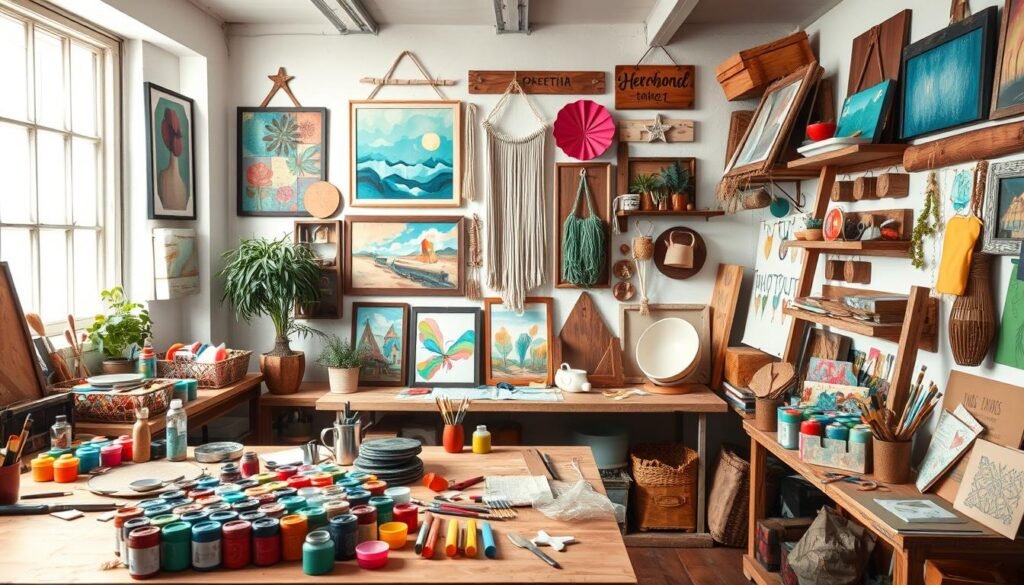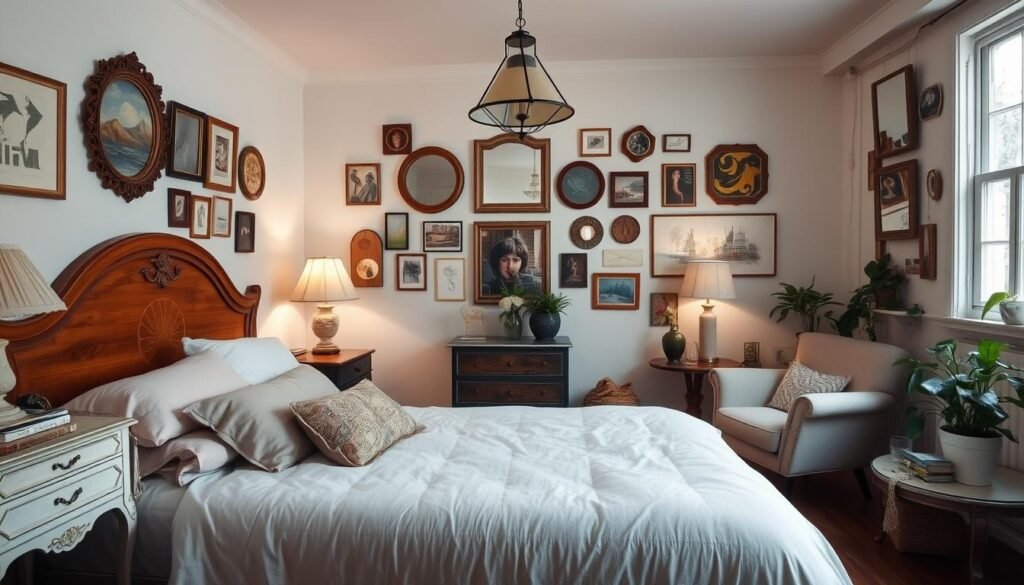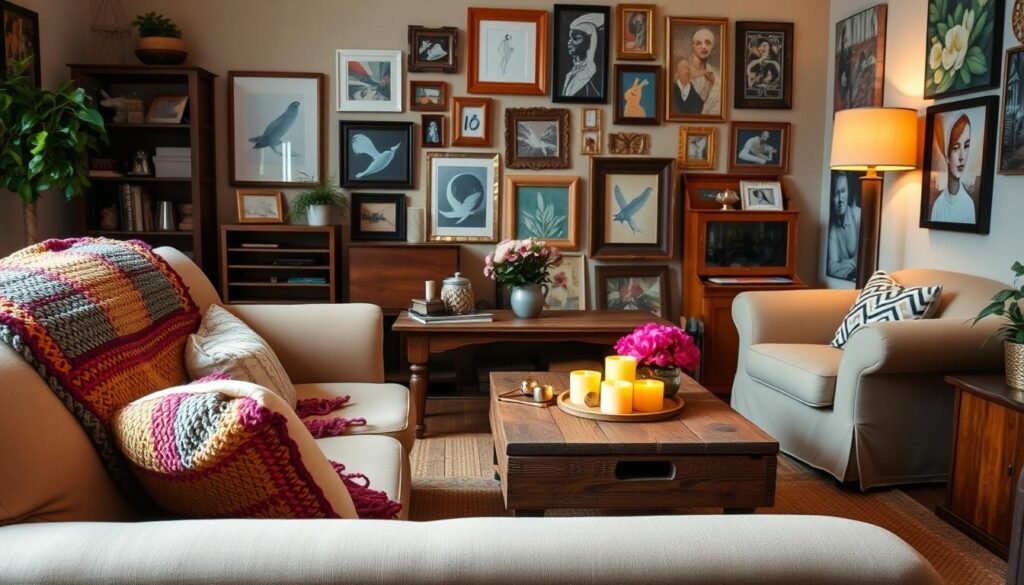Financial limitations don’t have to stifle your ability to create a stylish living environment. The secret lies in rethinking your approach to design. Instead of chasing store-bought trends, focus on resourcefulness – your greatest tool for crafting a space that feels uniquely yours.
Start by evaluating what you already own. Could that unused side table become a plant stand? Might old curtains transform into pillow covers? This mindset shift turns perceived “lack” into creative fuel. Neighborhood platforms like Facebook Marketplace often offer free furniture, while nature provides endless decorative elements like branches or stones.
Resist the urge to compare your space to social media perfection. Authenticity trumps expensive accents every time. A single thrifted mirror or handmade wall arrangement often makes more impact than generic store displays. Seasonal swaps become adventures when using foraged greenery or repurposed textiles.
Key Takeaways
- Creativity beats cash when transforming spaces
- Existing items often have untapped potential
- Community resources offer hidden treasures
- Personal style matters more than price tags
- Temporary challenges spark lasting solutions
Understanding the Budget-Friendly Mindset
Limited funds don’t limit style—they inspire innovative thinking. The journey to a refreshed living space begins by viewing financial constraints as creative catalysts rather than obstacles. This approach transforms budget limitations into opportunities for personalized solutions that reflect your unique taste.
Embracing the No-Spend Philosophy
The no-spend philosophy isn’t about deprivation—it’s about liberation from consumer cycles. By focusing on imagination instead of store aisles, you discover how empty walls become canvases for shadow art, or how mismatched mugs evolve into herb planters. As one designer notes: “The best rooms tell stories, not price tags.”
Finding Value in What You Already Own
Every home holds hidden potential. That ladder in the garage? It’s a bookshelf waiting to happen. Old scarves? Instant curtain tiebacks. This mindset shift helps save money while creating spaces that feel authentically yours. The key lies in seeing ordinary things through new lenses—asking “What else could this be?” instead of “What’s missing?”
Successful budget design thrives on gratitude for existing resources paired with playful experimentation. When you stop chasing trends and start crafting solutions, financial limits become stepping stones to originality.
Embracing No-Spend Home Decor Ideas
Transforming your space without spending starts with seeing possibilities in the ordinary. A stack of hardcover books becomes a sculptural side table. That spare ladder? It’s now a bohemian blanket rack. This approach turns repurposing into an art form, where functionality meets imagination.
Repurposing Everyday Items
Successful redesign begins by asking one question: “What else could this do?” Bedside cabinets pushed together create instant media consoles. Colanders transform into hanging planters. The trick lies in focusing on an object’s size, texture, and shape rather than its original purpose.
Try these swaps to spark creativity:
| Original Use | New Purpose | Style Impact |
|---|---|---|
| Magazine stack | Bedside table | Eclectic focal point |
| Storage baskets | Wall art grouping | Textural dimension |
| Kitchen colander | Plant holder | Industrial charm |
Simple modifications make big differences. Rotate a bookshelf sideways to craft a room divider. Use vintage suitcases as nested coffee tables. The goal isn’t perfection—it’s discovering unexpected beauty in what you already own.
Embrace trial and error. That ceramic vase might work better as a utensil holder. Those leftover tiles? Try them as coasters. With each experiment, your space gains character while your wallet stays intact.
decorate home when you are broke: A Mindset Shift
True style isn’t bought—it’s cultivated through clever reinvention. Financial limitations become springboards for innovation when we reframe challenges as design opportunities. This mental pivot transforms empty walls into blank canvases and mismatched furniture into eclectic statements.
Changing Your Perspective on Decor
What if scarcity fuels better design decisions? Limited money forces sharper focus on what truly matters. That chipped vase becomes a paintbrush holder. Those leftover fabric scraps? Wall hangings waiting to happen. As designer Nate Berkus observes: “The best spaces evolve through problem-solving, not purchasing.”
Using Creativity to Overcome Budget Constraints
Three principles guide this approach:
- Reinterpret objects based on shape and texture
- Celebrate imperfections as character markers
- Prioritize emotional resonance over trends
A stack of vintage suitcases makes a quirky side table. Framed postcards create gallery walls without the gallery price tag. This style evolution happens when we stop chasing store-bought solutions and start seeing potential everywhere.
The most memorable spaces often emerge from constraints. That thrifted mirror reflecting afternoon light? It tells a better story than any mass-produced decor. Your look becomes uniquely yours when financial limits spark inventive workarounds.
Remember: Great design isn’t about what you spend—it’s about how you see. With time and imagination, even the most humble items can transform a room’s energy.
Shopping Your Home for a Fresh Look
Your next style refresh might already exist within your four walls. Room rotations – moving decor between spaces – can create dramatic changes without spending. Start by walking through your house with fresh eyes, imagining how that hallway mirror might brighten the living room or how spare pillows could energize a bedroom.
Rearranging Furniture and Accessories
Shift your sofa to face a different wall. Swap lamps between bedrooms and common areas. These simple moves alter light patterns and traffic flow. A bookshelf turned sideways becomes a room divider, while a dresser relocated to the living room adds storage and character.
Try this three-step approach:
- Clear one wall or corner completely
- Experiment with furniture groupings
- Rotate accessories from other rooms
Finding Hidden Treasures in Your Space
Open closets and storage bins with intention. That unused vase makes a perfect utensil holder. Fabric scraps become table runners. As designer Emily Henderson notes: “The best decor often hides in plain sight.”
Common overlooked items with potential:
| Item | New Use |
|---|---|
| Bakeware | Desk organizers |
| Ladder | Blanket display |
| Picture frames | Tray surfaces |
These rediscoveries spark joy while keeping your budget intact. The house becomes a treasure hunt where every find tells your unique story.
Reuse and Repurpose to Refresh Your Style
Breathing new life into your space starts with seeing everyday objects as style chameleons. That chipped serving tray? It’s now a statement wall shelf. Those mismatched chairs? A curated dining set with fresh paint. This approach lets you evolve your aesthetic without breaking the bank.
Repurposing works best when you focus on an item’s potential rather than its original use. Design icon Iris Apfel once noted: “Personal style thrives on reinvention, not replacement.” Try turning vintage suitcases into nested side tables or transforming picture frames into chic tray surfaces. Each creative swap adds layers to your space while keeping costs at zero.
Three unexpected transformations to try:
- Use cake stands as bathroom organizers
- Convert ladders into plant displays
- Style baking sheets as magnetic memo boards
These changes do more than refresh rooms – they help identify what truly resonates with your taste. That ceramic vase you turned into a lamp base? It might reveal a love for earthy textures you never noticed before.
The magic happens when pieces solve functional needs while expressing personality. An old door becomes a headboard, storing bedtime essentials in its panels. Woven baskets morph into floating wall storage. With each successful project, your confidence grows alongside your unique style vocabulary.
DIY Art and Craft Ideas for Budget Decor
Personal expression through art thrives when resources are limited. Your walls become canvases for creativity using everyday materials. Forget store-bought prints – meaningful art emerges from coffee-stained paper, fabric remnants, or even mismatched dishware displayed as sculptural elements.

Creating Art from What You Have
Start with seasonal inspiration. Pressed autumn leaves arranged in frames create instant warmth. Not confident with brushes? Try these alternatives:
- Frame vintage postcards as mini gallery displays
- Arrange colorful mugs on floating shelves
- Stretch patterned scarves over canvas frames
Designer Justina Blakeney advises: “Imperfections add soul to spaces.” Involve kids in finger-painting sessions – their abstract creations often become cherished focal points.
Innovative Upcycling Tips
See potential in unexpected places. Old book covers become textured wall panels. Leftover wallpaper samples transform into bold statement art. Follow these principles for cohesive results:
- Group items in odd numbers for visual balance
- Repeat color tones across pieces
- Mix textures like wood, metal, and fabric
That stack of magazine pages? Fold them into origami shapes and hang as mobile art. Every creation tells your story better than mass-produced decor ever could.
Thrift Store Finds and Yard Sale Treasures
Unearthing hidden gems requires equal parts strategy and curiosity. Secondhand shopping transforms budget limitations into opportunities for discovery, where a $5 vase might outshine its $50 counterpart. The thrill lies in spotting potential beneath dust – a skill that sharpens with practice.
Hunting for Affordable Decor Pieces
Successful treasure hunters know timing is key. Early birds catch weekend yard sales, while latecomers often snag freebies as sellers pack up. Neighborhood exchanges yield surprising results – that “ugly” painting could become a frame-worthy canvas with fresh paint.
Build relationships with thrift store staff. Many will alert regulars about incoming shipments. As designer Genevieve Gorder advises: “Great style isn’t about what you spend – it’s about what you see.”
Three rules for secondhand success:
- Carry measuring tape and color swatches
- Inspect items for structural integrity
- Imagine pieces outside their current context
Facebook Marketplace’s free section overflows with seasonal decor. Search “fall books” at local thrift stores – burgundy and gold covers make instant autumn displays. With patience, you’ll assemble a space rich in history and character, where every piece tells a story.
Switching Decor Between Rooms for a New Vibe
Redecorating becomes revolutionary when you realize your best accessories already live with you. That lamp collecting dust in the guest bedroom? It might be the missing room element your living space craves. This approach turns your entire house into a design lab where every item holds multiple possibilities.

Shopping the House for Inspiration
Systematic decor rotations create instant transformations. Move that abstract painting from the hallway to above the sofa – suddenly, your living room gains an artistic focal point. A red lamp shifted to the dining area might echo hues in a kitchen rug, creating visual harmony without new purchases.
Try this three-step method:
- Photograph each room to spot underused items
- Cluster accessories by color/texture groups
- Experiment with unexpected placements
Seasonal shifts offer perfect opportunities. Swap heavy wool throws to bedrooms during summer, letting lighter linens take center stage. As designer Emily Henderson suggests: “The magic happens when we see our possessions as nomadic style elements rather than fixed decor.”
This strategy reveals hidden potential. Those nautical bathroom prints might energize a home office. A rustic bench from the entryway could become a coffee table alternative. Each switch costs nothing but delivers fresh energy to your living environment.
Clever Lighting and Accessory Ideas for a Cozy Ambiance
Light holds transformative power in any space. Strategic illumination can turn bland corners into inviting nooks using existing resources. The key lies in reimagining fixtures and accents you already own.
DIY Lamp and Light Upgrades
That outdated lamp in the guest room? It’s a style chameleon waiting to happen. Designers often note: “A $5 spray paint can outperform a $50 replacement.” Try these simple transformations:
| Original Item | Upgrade | Impact |
|---|---|---|
| Basic table lamp | Metallic finish + patterned shade | Modern focal point |
| Desk light | Washi tape geometric design | Personalized art piece |
Switch fixtures between rooms to create new color connections. A living room lamp might highlight dining area artwork when repositioned. Warm white bulbs instantly add warmth compared to cool alternatives.
Accent Pieces That Make a Difference
Three budget-friendly ways to amplify ambiance:
- Cluster thrifted candle holders near windows
- Drape fairy lights over curtain rods
- Place mirrored trays under existing decor
These tricks bounce light around rooms while adding visual interest. A reflective table surface doubles candle glow, creating restaurant-worthy mood lighting. The best part? Most solutions use items already in your space.
Remember: Layered lighting creates depth. Combine overhead fixtures with task lamps and accent glow for professional-level results. Your wallet stays happy while your rooms gain character.
Maximizing Impact with Minimal Changes
Subtle shifts often create the most dramatic transformations. Focus on high-impact areas that shape a room’s look – a statement wall, focal furniture piece, or lighting arrangement. These elements dictate visual flow without requiring major investments.
Start by making a priority list of existing features. Could shifting the sofa 45 degrees improve conversation areas? Would lowering artwork eye level enhance coziness? Small tweaks to lighting angles or shelf displays refresh your space instantly.
Three low-effort upgrades with big returns:
- Rotate rugs to define new zones
- Cluster decorative things in triangular formations
- Swap lamp shades between rooms
Remember: Great design thrives on intentionality, not abundance. A single well-placed mirror or thoughtfully arranged bookshelf often outshows crowded decor. Let your evolving taste guide gradual improvements – the most satisfying spaces grow through thoughtful iteration.

